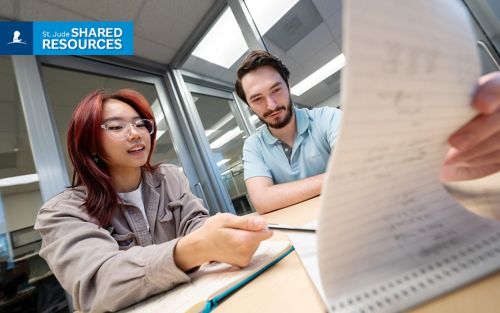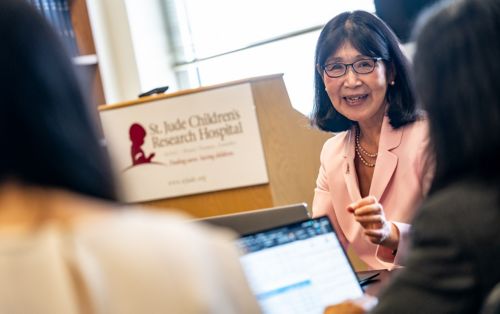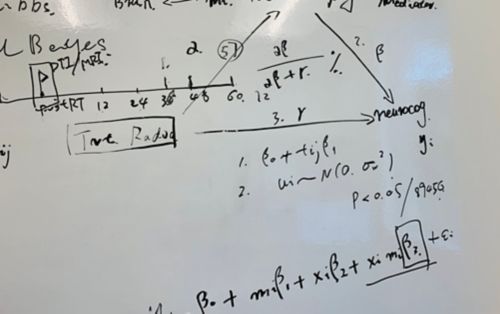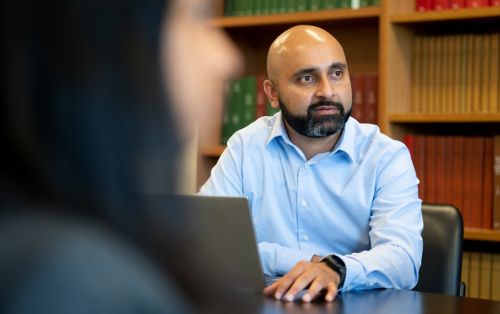St. Jude Family of Websites
Explore our cutting edge research, world-class patient care, career opportunities and more.
St. Jude Children's Research Hospital Home

- Fundraising
St. Jude Family of Websites
Explore our cutting edge research, world-class patient care, career opportunities and more.
St. Jude Children's Research Hospital Home

- Fundraising
Shared Resources Spotlight: Biostatistics Shared Resource

Emily Zeng and Jesse Smith, members of the Biostatistics Shared Resource team discuss their work.
When done well, biostatistics can fly under the radar in a research study. But when biostatistics is put on the back burner, the ramifications can be nearly insurmountable. Tomi Mori, PhD, MBA, St. Jude Department of Biostatistics endowed chair, described this as biostatisticians being “everywhere and nowhere,” touching every aspect of research while also being understated.

Tomi Mori, PhD, Department of Biostatistics chair and leader of the Biostatistics Shared Resource leads her team in a meeting.
While integral and nuanced, biostatistics can get overlooked, but at St. Jude, statistical methodology impacts all areas of research, both through the work of the St. Jude Department of Biostatistics with independent faculty pursuing research and the Biostatistics Shared Resource (BSR). The BSR, which comprises staff and faculty within the Department of Biostatistics, supports scientific discovery by instilling study development with statistical rigor, preparing data for analysis, carrying out statistical analysis and working across the entire breadth of laboratories and clinical groups within St. Jude.
The BSR is one of several Shared Resources at St. Jude, leveraging specialized expertise and innovative technologies to help investigators achieve their research goals.
A foundation for research
In his office, Cai Li, PhD, St. Jude Department of Biostatistics and BSR, sits in front of a whiteboard filled with notes and equations.
“This is neuroimaging,” Li said. “I just drew those things with my group members, and we had a lot of discussion.”

Cai Li, PhD, draws on the whiteboard in his office to showcase what it looks like to represent neuroimaging in terms of biostatistics.
While Li has a honed skill set and focuses on neuroimaging, genetics and neurobiology in his work as St. Jude faculty, BSR members aren’t restricted to specific fields.
“What we do, it’s a skill set that’s very transferable and can be applied to any disease area,” said Suraj Sarvode Mothi, BSR Senior Biostatistician. “We have the tools, but we get to play in everybody’s backyard.”
Jesse Smith, BSR Biostatistician, spends the bulk of his time-sharing data collection ideas, cleaning data, ensuring adherence to safety standards and answering questions during Biostatistics office hours.
“The perception is that we’re only focused on clinical trial-related projects,” Smith said. “But we have people supporting pretty much the entire breadth of research that’s going on at St. Jude.”
Reliable studies — clinical trials and beyond — need a statistical foundation to confirm significance and broader applicability.
“The biostatistics elements are a critical part of scientific rigor,” Mori said. She added that Institutional Review Boards may include biostatisticians to gauge studies’ integrity.
Defining unclear terms “is part of the game”
Some of the most important questions in research may initially go unanswered, but that’s when the BSR steps in.
“One thing that comes up all the time in data science is definitions. People have in their heads: ‘baseline.’ What does ‘baseline’ mean?” asked Subodh Selukar, PhD, St. Jude Department of Biostatistics. “Does ‘baseline’ mean the day before you give your treatment? Does it mean the week before? If you have multiple measurements, does that mean the last one before your treatment?”
As a Biostatistics faculty member, Selukar has worked with BSR members and said they could sometimes be the first to spot these details that could influence results.
Emily Zeng, BSR Associate Biostatistician and one of Selukar’s mentees, was part of that “baseline” conversation for a project looking at the efficacy of vaccines for patients before and after hematopoietic stem cell transplantation, a treatment that can leave patients’ immune systems weakened.
“It’s defining the variable in relation to the data,” Zeng said. “When we talked about a baseline titer or a baseline antibody, we wanted to see the baseline timeline,” she said, referring to measuring antibodies before and after vaccination.

Suraj Sarvode Mothi, a senior biostatistician in the Biostatistics Shared Resource explains how biostatistics is a widely applicable skill.
For Mothi, tracing how an ambiguous variable fits into a data table “is part of the game.”
Honing and standardizing terminology allows greater clarity while approaching research questions and smoother communication between scientists across institutions.
The earlier, the better
Leveraging the BSR earlier in a study — rather than just handing over the data after — lets biostatisticians assist with collecting and preparing data. This data collection mitigates issues that could arise during analysis, ultimately causing researchers to backtrack.
“Getting biostatisticians involved from a very early phase of research can be invaluable,” Mothi said. “Researchers should try to have us involved when they conceptualize a study and collaborate with us from then onwards.”
While biostatisticians may be “everywhere and nowhere,” they can be integral at every stage of the research process, from ideation to analysis.
Members of the BSR have been key team members for numerous publications and clinical trials. In the 2022–2023 fiscal year, this included supporting 182 investigator-initiated clinical studies and authorship of 161 published research papers. A few of these projects include:
- HAP2HCT: Partially matched family donor bone marrow transplant in children and young adults with high-risk cancer.
- REF2HCT: Haploidentical bone marrow transplant for leukemia and lymphoma.
- SJiMB21: Risk-based medulloblastoma treatment for infants and young children.
- cHOD17: Risk-adapted therapy for children and young adults with Hodgkin lymphoma.
- The genomic landscape of pediatric acute lymphoblastic leukemia, published in Nature Genetics.
- Improved outcome in children with newly diagnosed high-risk neuroblastoma treated with chemoimmunotherapy: Updated results of a phase II study using hu14.18K322A, published in Journal of Clinical Oncology.
- Pharmacotypes across the genomic landscape of pediatric acute lymphoblastic leukemia and impact on treatment response, published in Nature Medicine.
- Coadministration of CD19- and CD22-directed chimeric antigen receptor T-cell therapy in childhood B-cell acute lymphoblastic leukemia: a single-arm, multicenter, phase II trial, published in Journal of Clinical Oncology.
Thank you to Arzu Onar-Thomas, PhD, and Yiwang Zhou, PhD, for providing background.






